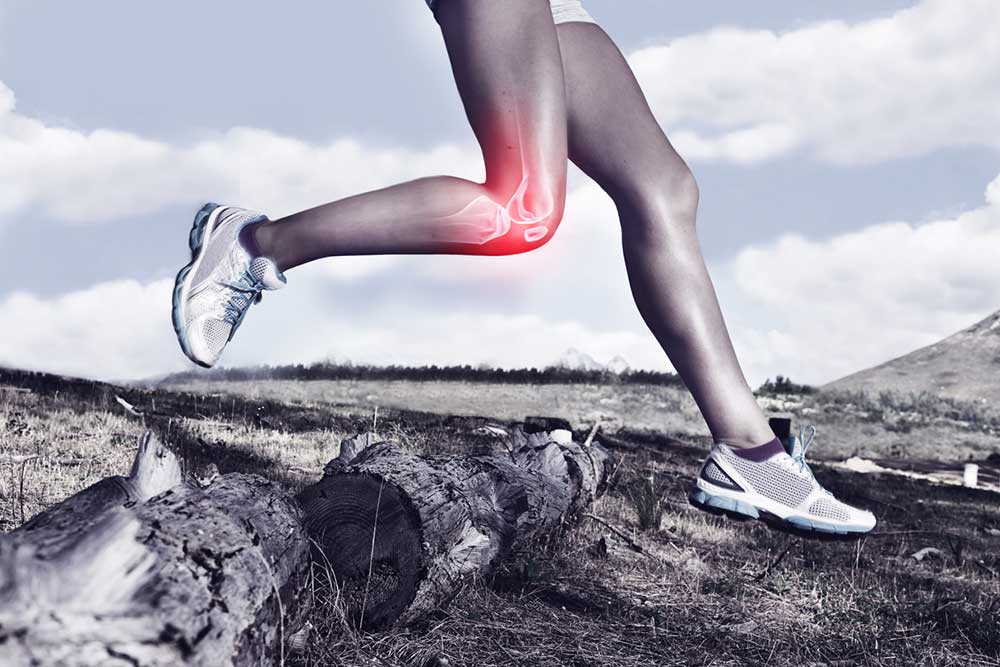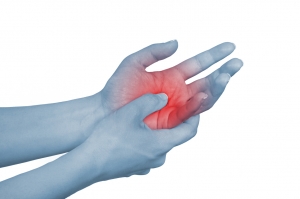High-Intensity Exercise with Rheumatoid Arthritis

Gillian White – MSc, PhD (C), University of Toronto, Department of Exercise Sciences
As I wrote about previously in “How to get active with rheumatoid arthritis”, there are lots of benefits to be gained from exercise in people living with rheumatoid arthritis. The article outlines guidelines around minimizing joint loads, while still getting a good muscle or cardiovascular workout. It can sound sort of paradoxical “low joint loads” and “high-intensity exercise” but it is not only possible to do high-intensity exercise, but in fact, more effective for improving fitness parameters like muscle strength, aerobic capacity, and range of motion, but also disease activity, functional ability, and other more clinical outcomes. This article will discuss the existing research on high-intensity exercise and rheumatoid arthritis, including benefits, risks, and tips on minimizing joint loads while getting a great sweat.
Specifically, this article will discuss:
- Is high-intensity exercise effective and well-tolerated in RA?
- Is it better than low-intensity exercise?
- Why is it important?
- Is it safe?
- What kinds of workouts should you do?
- Is high-intensity exercise effective and well-tolerated in RA:
In one word, Yes and yes.
Ok, that was two words, but you get it. It can be daunting for a person with RA to approach high-intensity exercise because, intuitively, you’re thinking more intense = more pain and possible worsening of symptoms. While it’s not especially surprising that patients with RA might think this, what is extremely surprising is that when rating expected outcomes of high-intensity exercise in RA patients, it’s the physiotherapists who are the most skeptical (Munneke et al. 2005). This is important because nearly all of the research shows that for most patients with Rheumatoid Arthritis, high-intensity exercise is not only safe but more effective at improving fitness, function, and pain scores than usual care physiotherapy.
The most recent evidence comes from a study by Sandstad et al. (2015) who investigated the effects of a high-intensity interval training program in women with RA or adult juvenile idiopathic arthritis. The participants did a spin workout with 4 bouts x 4 minutes each at 85-95% of their predicted HRmax (220-age). They had 3 minutes of active recovery at 70% HRmax between bouts. They did this workout 2x/week for 10 weeks and found improvements in VO2max (aerobic fitness), muscle strength, and BMI, body composition. While they found no statistical effect on disease activity, they did see a trend for decreased C-Reactive Protein, a marker of chronic inflammatory that is prognostic in disease progression and other health risks.
 While you might be thinking, ‘that’s great that they got more fit but their disease status didn’t change’ – to you I say a couple of things: 1. True, but the expectation was that exercise of a high intensity could make things worse and they saw that it is in fact safe and possibly more effective, 2. It was only 10-weeks so a difference in disease status may not come about until it’s more regular practice. This is supported by their findings of trends for decreased pain and improved markers of disease (ferritin, COMP, IL-6) but these weren’t statistically significant, which is the threshold used in peer-reviewed research for reporting findings, 3. The change in fitness is extremely important for long-term prognosis and health (see answer to question 3. Why is it important?). And they did see some evidence of reduced inflammation so that’s a good thing.
While you might be thinking, ‘that’s great that they got more fit but their disease status didn’t change’ – to you I say a couple of things: 1. True, but the expectation was that exercise of a high intensity could make things worse and they saw that it is in fact safe and possibly more effective, 2. It was only 10-weeks so a difference in disease status may not come about until it’s more regular practice. This is supported by their findings of trends for decreased pain and improved markers of disease (ferritin, COMP, IL-6) but these weren’t statistically significant, which is the threshold used in peer-reviewed research for reporting findings, 3. The change in fitness is extremely important for long-term prognosis and health (see answer to question 3. Why is it important?). And they did see some evidence of reduced inflammation so that’s a good thing.
- Is it better than low-intensity exercise or usual care physiotherapy?
Also, yes.
A couple studies have compared high-intensity exercise to physio or low-intensity exercise and overall the results show that high-intensity exercise is better for most people (see Question 5. Is it safe? for further discussion). de Jong et al. (2012) compared 2 years of high-intensity exercise to usual care physiotherapy in patients with RA. They found that after 2 years, people who had been randomized to high-intensity exercise showed greater functional ability and better emotional status, while again, finding no differences in disease progression (i.e. it’s safe and well-tolerated).
These findings are supported by shorter studies comparing high-intensity exercise (cycling at 70-85% HRmax + dynamic body weight resistance training) (van Ende et al. 1996) and high-intensity resistance training vs. low-intensity isometric + stretching programs (Lemmey et al. 2009). Both showed greater fitness gains in the high-intensity group, and no differences in disease progression, further indicating its efficacy and safety in people living with Rheumatoid Arthritis.
- Why is it important?
It is important for 3 major reasons: 1. Cardiovascular health, 2. Muscle mass maintenance, and 3. Inflammatory control and disease progression.
Because of the inflammatory nature of RA and the adverse health implications of high chronic inflammation, people with RA have a higher risk of cardiovascular disease, muscle atrophy, and associated quality of life losses. Compared to the general population, people with RA have a 1.5-1.6x higher risk of mortality, and 40-50% of deaths in people with RA are of a cardiovascular nature. This means that improving cardiovascular health with regular exercise can possibly reduce the risk of mortality in people with RA. Obviously, this is a good thing.
Muscle function is considered to be the most important physical attribute for maintaining quality of life with aging and RA is associated with inflammatory-mediated muscle atrophy. A lack of physical activity also likely contributes to muscle atrophy, but Lemmey et al. (2009) found that muscle strength increased 25% in their 24-week high-intensity resistance training program and this was related to improved overall function. Importantly, they related their change in muscle strength to changes in Insulin-like Growth Factor-1 (IGF-1) signalling, an inflammatory mediator, indicating a change in not only muscle growth and strength but also inflammatory wasting of muscles.
Another very important finding is the effects of high-intensity exercise training on joint health in patients with RA. While many studies have found no differences in disease activity with exercise, which I’ve proposed as an indication that it is “well-tolerated”, de Jong et al. (2004) found that while there may not be effects of disease progression in big joints, there are benefits of high-intensity exercise to health and function of smaller joints (i.e. hands/feet). They found that compared with 2 years of usual care physiotherapy, 2 years of high-intensity exercise was associated with lower progression of joint disease in small joints (increase of mean disease severity scores of 3.5 vs. 5.7).
They also found that the effects were greater for joints of the hands compared with joints of the feet, and that this smaller magnitude of disease progression was associated with lower disease activity (duh), and lower use of steroid medications. This is critical for quality of life and general functioning – keeping your hands healthy and functional is so important for almost everything we do and is absolutely essential for maintaining independence.
- Is it safe?
Generally speaking, high-intensity exercise is safe for people with Rheumatoid Arthritis. With that said, there is evidence that when a sub-population of people with severe joint damage at baseline undergo 2 years high-intensity exercise, they have greater disease progression of the large joints compared with patients undergoing usual care physiotherapy (de Jong et al. 2012). So, for people with severe RA, avoiding exercise that places excessive loading on joints is advised and they should therefore engage in lower impact physical activity like water-based activities, yoga/tai chi, or walking with poles. Talk to your rheumatologist and make a plan that works for your level of joint health. And for people with low to moderate severity RA, ramp up the intensity!
- What kinds of workouts should I do?
- Sandstad 2015
HIIT
Spin-bike
4x4minutes @ 85-95% HRmax (HRmax = 220-age)
3-minutes active recovery @ 70% HRmax between set
- de Jong 2003
Mixed
20-minutes cycling (70-85% HRmax; RPE 4-5/10)
20-minutes strength circuit (8-10 exercises, 8-15 reps; 90 seconds work: 60 seconds rest progressing to 30 seconds rest after 6 months)
20-minutes game (i.e. volleyball, baseball, basketball, badminton etc.)
- Lemmey 2009
Resistance Training
1 set in week one, 2 sets in week 2, progressing to 3 sets in week 3 and beyond (start here if you’ve been doing strength exercise regularly)
weeks 1-4: 15 reps @ 60% 1RM
week 5-6: 12 reps @ 70% 1RM
week 7 and beyond: 8 reps @ 80% 1RM
1-2-minutes rest between sets
Exercises: leg press, chest press, leg extension, seated row, leg curl, triceps extension, calf raise, bicep curl.
1 RM = max you can lift just once (“1 Repetition Max” – 1 RM)
References:
de Jong Z, Munneke M, Zwinderman AH, Kroon HM, Jansen A, Ronday KH, van Schaardenburg D, Dijkmans BA, Van den Ende CH, Breedveld FC, Vliet Vlieland TP, Hazes JM. (2003). Is a long-term high intensity exercise program effective and safe in patients with rheumatoid arthritis? Results of a randomized controlled trial. Arthritis Rheum. 48(9):2415-24.
de Jong Z, Munneke M, Zwinderman AH, Kroon HM, Ronday KH, Lems WF, Dijkmans BA, Breedveld FC, Vliet Vlieland TP, Hazes JM, Huizinga TW. (2004). Long term high intensity exercise and damage of small joints in rheumatoid arthritis. Ann Rheum Dis. 63(11):1399-405.
Munneke M, de Jong Z, Zwinderman AH, Ronday HK, van Schaardenburg D, Dijkmans BA, Kroon HM, Vliet Vlieland TP, Hazes JM. (2005). Effect of a high-intensity weight-bearing exercise program on radiologic damage progression of the large joints in subgroups of patients with rheumatoid arthritis. Arthritis Rheum. 53(3):410-7.
Lemmey AB, Marcora SM, Chester K, Wilson S, Casanova F, Maddison PJ. (2009).
Effects of high-intensity resistance training in patients with rheumatoid arthritis: a randomized controlled trial. Arthritis Rheum. 61(12):1726-34.
Sandstad J, Stensvold D, Hoff M, Nes BM, Arbo I, Bye A. (2015) The effects of high intensity interval training in women with rheumatic disease: a pilot study. Eur J Appl Physiol. 115(10):2081-9.
van den Ende CH, Hazes JM, le Cessie S, Mulder WJ, Belfor DG, Breedveld FC, Dijkmans BA. (1996). Comparison of high and low intensity training in well controlled rheumatoid arthritis. Results of randomised clinical trial. Ann Rheum Dis. 55(11):798-805.
You Might Like:
















